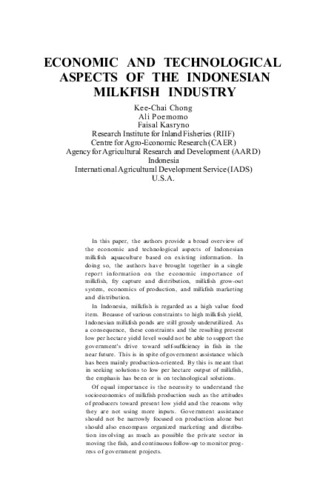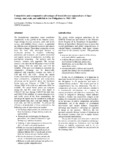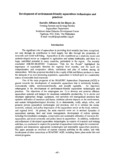Economic and technological aspects of the Indonesian milkfish industry
- Global styles
- MLA
- Vancouver
- Elsevier - Harvard
- APA
- Help

วันที่
1984Page views
8,912ASFA keyword
AGROVOC keyword
Taxonomic term
เมตาดาต้า
แสดงระเบียนรายการเต็ม
Share
นามธรรม
A broad overview is presented of the economic and technological aspects of Indonesian milkfish (Chanos chanos ) aquaculture covering information on the economic importance of milkfish, fry capture and distribution, milkfish grow-out system, economics of production, and milkfish marketing and distribution. In Indonesia, milkfish is regarded as a high value food item. Because of various constraints to high milkfish yield, Indonesian milkfish ponds are still grossly underutilized. As a consequence, these constraints and the resulting present low per hectare yield level would not be able to support the government s drive toward self-sufficiency in fish in the near future. Understanding socioeconomics of milkfish production such as the attitudes of producers toward present low yield and the reasons why they are not using more inputs is of importance. Government assistance should not be narrowly focused on production alone but should also encompass organized marketing and distribution involving as much as possible the private sector in moving the fish, and continuous follow-up monitor progress of government projects.
การอ้างอิง
Chong, K-C., Poernomo, A., & Kasryno, F. (1984). Economic and technological aspects of the Indonesian milkfish industry. In J. V. Juario, R. P. Ferraris, & L. V. Benitez (Eds.), Advances in milkfish biology and culture: Proceedings of the Second International Milkfish Aquaculture Conference, 4-8 October 1983, Iloilo City, Philippines. (pp. 199-213). Metro Manila, Philippines: Published by Island Pub. House in association with the Aquaculture Department, Southeast Asian Fisheries Development Center and the International Development Research Centre.
Type
Conference paperISBN
9711007045คอลเลกชัน
Related items
Showing items related by title, author, creator and subject.
-
The Philippine aquaculture industry
Camacho, Arsenio S.; Macalincag-Lagua, Natividad (Aquaculture Department, Southeast Asian Fisheries Development Center, 1988)The aquaculture sector of the Philippine fishing industry registered the highest growth rate of 12.5% in 1977-1986. The contribution of aquaculture to the total fish production was equivalent to 24% in 1986 compared to ... -
Competitive and comparative advantages of brackishwater aquaculture of tiger shrimp, mud crab, and milkfish in the Philippines in 1985-1995
Gonzales, Leonardo A.; Elca, C. D.; Gonzales, V. A.; Alviola IV, Pedro A.; Paraguas, F. J.; Olalo, C. (Bureau of Agricultural Research, Department of Agriculture, 2007)The brackishwater aquaculture sector contributes considerably to the growth of the fisheries sector. Tiger shrimp Penaeus monodon, mud crab Scylla serrata, and milkfish Chanos chanos, in particular are efficient users of ... -
Development of environment-friendly aquaculture technologies and practices
de los Reyes Jr., Aurelio Alfonso (Japan International Research Center for Agricultural Sciences, 2002)The significant role of aquaculture in providing food security has been recognized, not only through its contribution to food supply, but also through the promotion of economic and social well-being. Aquaculture is also ...






